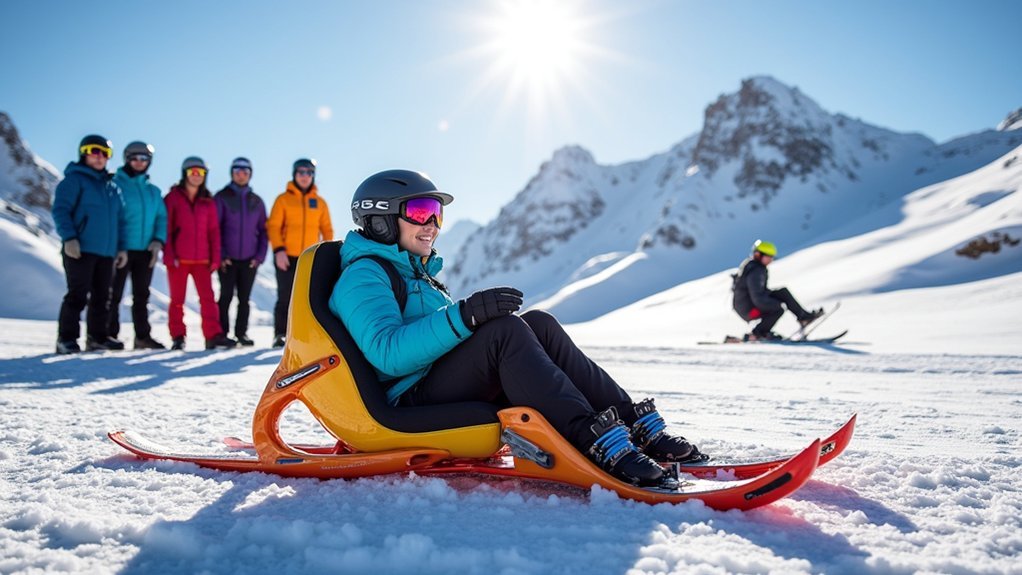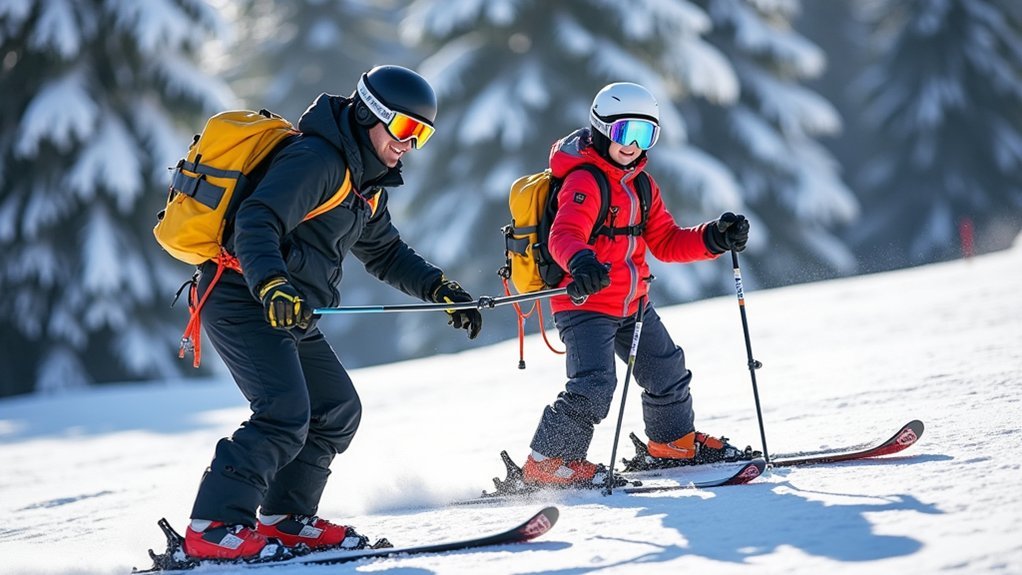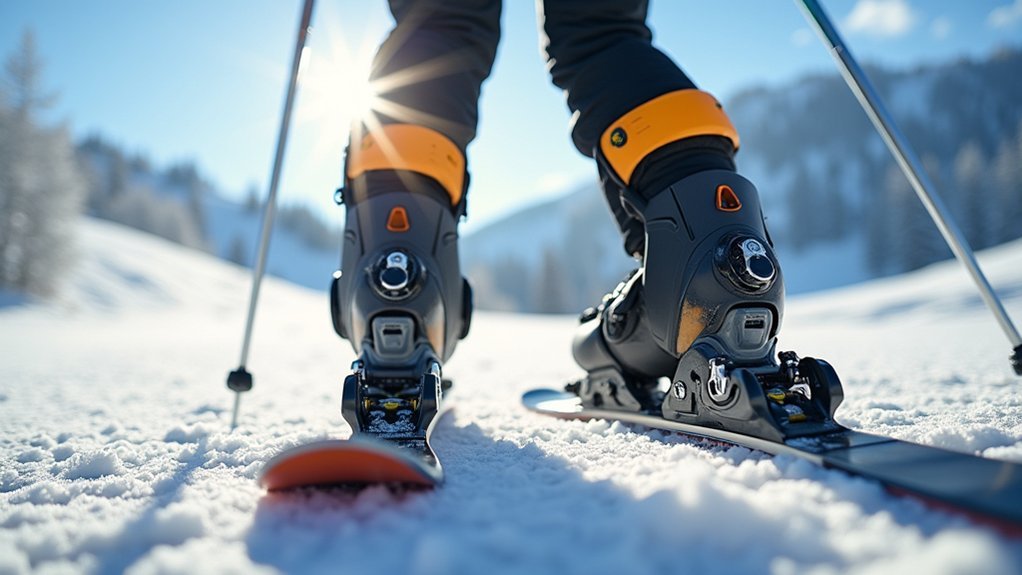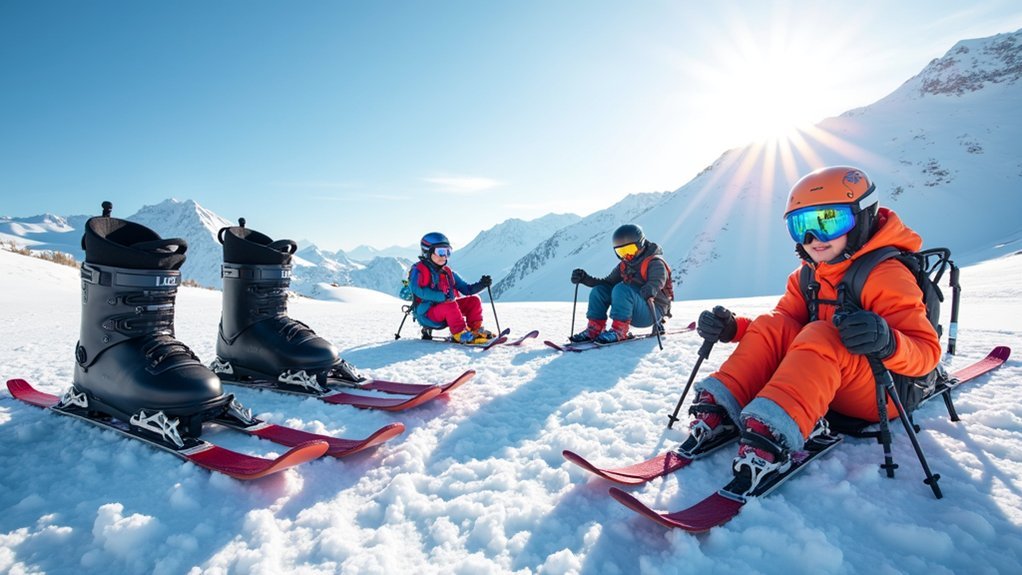Adaptive skiing gear has revolutionized winter sports for cerebral palsy adventurers. You’ll find sit-ski systems offering enhanced stability through bucket-style seating on either mono or bi-skis. Specialized outriggers provide essential balance with adjustable features for your unique needs. Tethering equipment connects you safely to instructors while allowing natural movement. Sensory-friendly helmets reduce pressure points and accommodate sensitivities. Terrain-responsive frames with shock absorption technology minimize vibrations on challenging slopes. These innovations open mountains of possibilities for your next adventure.
Adaptive Sit-Ski Systems Designed for Enhanced Stability

The evolution of adaptive sit-ski systems has revolutionized winter sports accessibility for people with cerebral palsy.
You’ll find two primary options tailored to different mobility needs: the Bi-Ski and Mono-Ski.
The Bi-Ski features a bucket-style seat mounted on two skis, offering superior stability for those with more significant mobility challenges. You can steer by shifting your head and shoulders or using outriggers.
If you have stronger upper body control and trunk stability, a Mono-Ski might be your ideal choice. This single-ski system incorporates adjustable straps and specialized padding for comfort while requiring outriggers for balance.
Both adaptive equipment options prioritize security and control, allowing you to experience the thrill of skiing regardless of your cerebral palsy symptoms.
These innovations guarantee you’ll enjoy an inclusive skiing experience with proper support.
Specialized Outriggers With Customizable Support Features
Specialized outriggers stand as the cornerstone of adaptive skiing for individuals with cerebral palsy, providing the essential balance and stability needed to navigate snowy slopes with confidence.
You’ll find these innovative tools feature adjustable height and width options, accommodating your unique body type and skiing preferences.
Built with lightweight materials, these outriggers enhance your maneuverability despite physical limitations, making it easier to tackle varied terrains.
The Velcro attachments offer superior grip, ensuring you feel secure throughout your skiing experience.
What’s truly remarkable about these customizable support systems is how they empower your independence.
With the right outriggers, you’ll join friends and family in adaptive skiing adventures, experiencing the thrill of the sport without compromise.
This technology bridges gaps, transforming limitations into possibilities.
Adjustable Tethering Equipment for Instructor-Assisted Skiing

While outriggers provide individual support for skiers with cerebral palsy, many adventures on the slopes benefit from human connection.
Adjustable tethering equipment creates that essential link between you and your instructor, offering crucial support and stability while preserving your independence on the slopes.
- Picture yourself gliding down a run with confidence as the tethering system adjusts to your varying levels of strength and coordination.
- Imagine the security of knowing your instructor can provide immediate assistance through integrated communication systems.
- Visualize the rounded outriggers or harness connecting you safely while allowing natural movement.
- See yourself progressively gaining more control as the tethering adjusts to your increasing skills.
You’ll experience enhanced safety while developing confidence through this specialized instructor-assisted skiing approach.
Sensory-Friendly Helmet and Safety Gear Modifications
Experiencing the thrill of skiing shouldn’t be compromised by uncomfortable or ill-fitting protective gear, which is why sensory-friendly helmets and safety equipment have revolutionized the adaptive skiing landscape.
You’ll find these helmets feature soft padding and adjustable fit systems that reduce pressure points, addressing heightened sensitivity concerns.
Safety gear modifications now incorporate lightweight materials and flexible designs to enhance your mobility on the slopes. The customizable features, including removable ear pads and ventilation systems, help manage temperature and sound sensitivity during your skiing adventures.
For improved safety, visibility features like reflective materials and bright colors guarantee you’re easily spotted on the mountain. Quick-release buckles and specialized chin straps accommodate limited dexterity, making adjustments and removal simpler—allowing you to focus on enjoying the exhilaration of adaptive skiing.
Terrain-Responsive Ski Frames With Shock Absorption Technology

Revolutionary terrain-responsive ski frames have transformed adaptive skiing for individuals with cerebral palsy by incorporating advanced shock absorption technology.
These innovative frames adapt to different terrain types, minimizing vibrations that can be particularly challenging for those with neuromuscular conditions.
You’ll experience enhanced stability and control with these customizable setups that manufacturers like Enabling Technologies have specifically engineered for adaptive sports enthusiasts:
- Specialized dampening materials that absorb jarring impacts when traversing uneven snow surfaces
- Adjustable frame components that respond differently to packed powder versus icy conditions
- Precision-balanced support structures that compensate for balance challenges common in cerebral palsy
- Multi-axis shock systems that filter unwanted vibrations while maintaining performance feedback
This technology guarantees you’ll enjoy smoother rides across varied slopes with equipment tailored to your unique needs.
Frequently Asked Questions
What Kind of Skis for Cerebral Palsy?
You’ll find three-track skiing (one ski with outriggers), four-track skiing (two skis with outriggers), mono-skis, bi-skis, or snow sliders beneficial. Your specific needs and mobility level determine which option works best for you.
How Do Disabled People Ski?
You’ll ski using specialized adaptive equipment like mono-skis, bi-skis, or outriggers. Depending on your disability, you might use techniques like three-track skiing or guided systems with an instructor for visual impairments.
What Equipment Is Used in Sit Down Skiing?
In sit-down skiing, you’ll use equipment like Bi-Skis (bucket seats on two skis), Mono-Skis (single ski with molded seat), or Snow Sliders (walker-like frames on skis). You’ll also need outriggers for balance and control.
How to Look Cool While Skiing?
You’ll look cool while skiing by wearing sleek, colorful gear that fits well. Don’t forget stylish helmets, goggles, and personalized accessories. Confidence matters most—ski with good posture and a genuine smile!
In Summary
You’ve now discovered gear that can transform your mountain adventures with cerebral palsy. These innovations don’t just make skiing possible—they make it enjoyable and accessible on your terms. Whether you’re trying a sit-ski or using specialized outriggers, you’ll find equipment that adapts to your unique needs. Don’t wait to hit the slopes and experience the freedom of adaptive skiing firsthand.





Leave a Reply